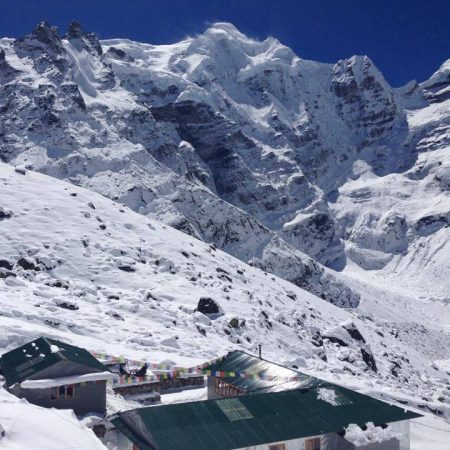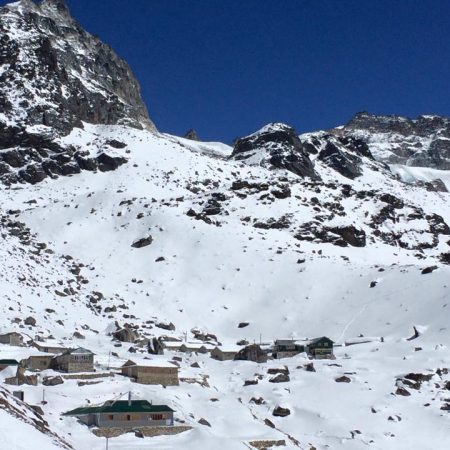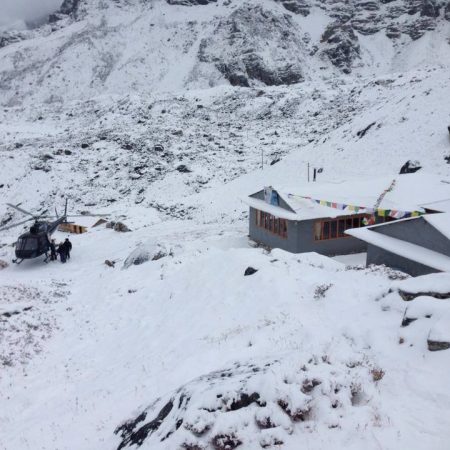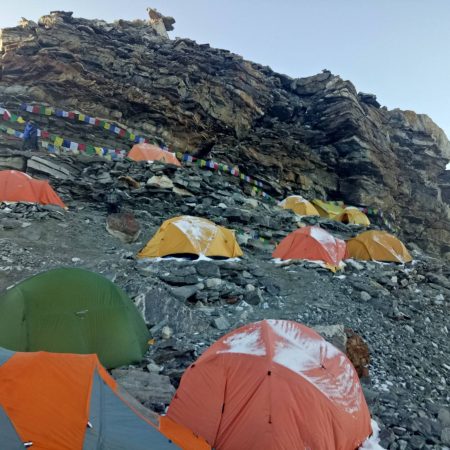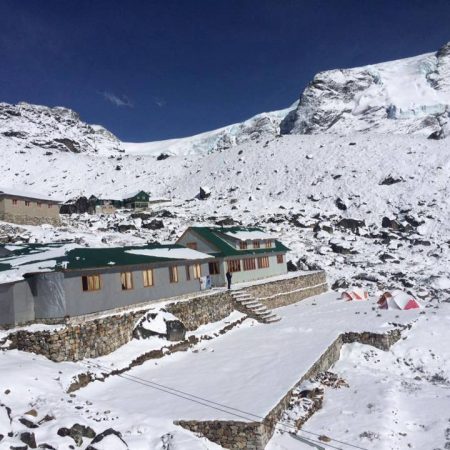19 days
6476 m
Kathmandu/Kathmandu
Trip Overview
Mera Peak Climbing takes us to the summit of Mera Peak (6,461m/21,190ft) which is the highest trekking peak in Nepal. A trekking peak is defined thus by HMG; permit and climbing fee are required. Mera peak is situated on the edge of famous Khumbu Region which is dominated by Mt. Everest. It is an adventure peak with technical difficulties and has stunning views of the world’s 8000 meter Mountains- Everest, Kanchenjunga, Makalu, Lhotse, Cho-Oyu from the summit of it. It’s a challenging trekking peak due to the elevation but technically only requires basic mountaineering skills to tackle the high-altitude glacier crossings. Identically we customise the climbing training course covering various aspects of climbing techniques and skills. The training covers the glacier travel, rope fixing, ascending and descending etc. Indeed, the day training ensure you have necessary climbing skills and confidence to scale the summit successfully.
In fact, three peaks combine to make up Mt. Mera; Mera South (6065m), Mera Central (6461m) and Mera North (6476m). Our target summit is Mera Central.
The expedition starts with early morning dramatic flight from Kathmandu to the small mountain airstrip at Lukla, in the heart of the Khumbu/Everest region offering fantastic views. The trek begins with walk to the south of Lukla before crossing two quite low passes to join the Inkhu Valley. This river valley is isolated and rarely sees visitors. We then walk through the pristine of Rhododendron, pine forest and streams. We follow the river north towards Upper Inkhu. Eventually, the forests give way to alpine meadow and by the yak pastures of Thangnak. You will be amazed by the sight of Mt. Charpate and Mera La along with the Buddhists Gumba in the lap of the big rock to Thangnak. The valley has widened out to offer impressive views of the west face of Mera Peak and Peak 43, and being in this classic high Himalayan valley has a rare sense of splendid isolation.
From Thangnak, our trail takes us eastwards across the moraine of the Dig Glacier. It will be a couple hours before we reach open pasture at Dig Kharka and then make a steep ascent to Khare (4896m). Our trail to Mera Camp starts. Base Camp is set up above here at around 5400m – near the ‘Mera La’ Pass (5415m). Here we use a ‘spare day’ provided to allow for possible dodgy weather and acclimatization and/or to practice mountain skills before moving on to establish High Camp on one edge of the Mera Glacier. Our ascent up the glacier requires use of crampons, harness and ropes, and calling for a keen eye and a prodding ice axe to detect possible crevasses. With conditions favourable, we will make our summit push from here.
Early morning before dawn on summit day, we will leave High Camp to negotiate the upper glacier to reach the first false summit by sun-up. It is usually necessary to rope up for much of the summit approach due to crevasse hazards along the route. We’ll continue steadily onwards and upwards towards the Central Summit holding enough in reserve for the seriously breath-taking, seriously steep, final ascent. Although physically demanding, the mountaineering itself is actually graded ‘easy’. From the summit can be seen the magnificent views of Mt. Everest (8,848m), Cho-Oyu (8,210m), Lhotse (8,516m), Makalu (8,463m), Kangchenjunga (8,586m), Nuptse (7,855m), Chamlang (7,319m), Baruntse (7 ,129m), Ama Dablam (6,812m), Kangtega (6,779 m) and many peaks over six thousand. After achieving the summit, you retrace your steps down to high camp and to Khare, to be greeted in camp by the support crew with all the most essential creature comforts.
With low oxygen levels (44%) at the summit of Mera Peak it will certainly test resolve, stamina and character. Low oxygen environments find weakness in the body so be prepare to develop a strength and conditioning program that builds slowly. This reality, combined with Mera’s definitive mountain landscapes makes it, in the opinion of many, the most rewarding non-technical climb on offer anywhere.
The trekking peak/climb involves anything between 6 and 10 hours walking per day, some of it before sun-up. There are steep ascents/descents and the high altitude temperatures will be extremely low. You will need at least some experience of winter recreational conditions and to be equipped with quality personal climbing gear.
Trip Itinerary
Arrival in Kathmandu (Tribhuvan International Airport), transfer from airport by private bus to Kathmandu Guesthouse or equivalent. Free evening, short pre-tour briefing before dinner.
Guided tour around Kathmandu, which includes visits to places listed in UNESCO World Heritage Sites and some historic and religious significance, such as Pashupatinath, Boudhanath & Swayambhunath (Monkey Temple), Hindu temples, Old palaces (in and around Durbar Square Area) and inner-city market squares.
Early morning after breakfast, we get transferred to domestic airport to fly to Lukla. After an adventurous 40-minute flight above breath-taking green and white mountains, we reach Tenzing-Hillary Airport at Lukla. Porter loads are organised and we set off. We descend steeply towards the Dudh Koshi (the river that comes from the flanks of Everest), passing an array of travellers and the first encounters with the extraordinary Sherpas carrying gravity defying stacks of goods to markets up in Namche Bazaar. We walk through the jungle to arrive in Surke. A further 2 hours steep up brings us to our lunch prepared by our cooks at the cool. We continue through rhododendron forest that in the pre-monsoon is awash with reds and pinks. The huge Magnolia trees add their large white flowers to the canvas as we enjoy a level walk to our night stop in Paiya.
After breakfast, we descend a little until we reach wooden bridge and then carefully we have to go ahead through the slippery trail to cross the Khari La pass (2860m), with today’s destination already visible in the distance. We pass through dense forest of rhododendron and bamboo with occasional glimpses of the white peaks emerging above the clouds. A gradual hour-long descent to lunch is followed by a steady climb for 2 ½ hours with outstanding views of Dudhkoshi River valley and Dudh Kund Himal to our tents pitched near the picturesque village of Pangum.
A short climb brings us to the Pangum La (3010m) where we cross over into the fabled, awesome and empty Inkhu Valley. We walk through rock-strewn path leading to the rhododendron forest. We pass through the village of Bhusme (approx. 1hr on), which is the last permanent habitation we shall see. It’s another 3 hour walk to our night stop at Ningsow; just a name and a couple of shepherd’s huts in a forest clearing. We experience the most interesting and charming feelings as we walk past forests of pine and rhododendron to reach Ningsow.
Today is a long day of the trek. Climbing and descending the steep and rugged spurs that line the Inkhu Khola valley; the glimpses through the dense rhododendron and bamboo forest of the torrent below us are truly dramatic. We pass in the course of landslides and down we reach to the stream. Straight ahead and up through the rhododendron forests we may encounter wild animals if we are lucky. A little down through the bamboo jungle and past a cave under huge overhanging stone deep in the forest by the side of a river, we will camp for the night's rest.
Chirping birds wake us up early in the morning. We start our short but 500m climb after breakfast and reach a fine vantage point which offers interesting views; South to the rolling foothills of a few days before, North to Mera Peak itself and our first sight of its dramatic southwest face. The forest is untouched, beautiful, tall pine and mossy, lichen rhododendron creating a peaceful soulful feel during today’s walk and there is possibility of encountering with mountain wild animals like sloth bear, jungle cat, etc., among the tall pine trees as we descend to the upper Inkhu Khola and arrive at a few huts and the summer yak pastures that is Kothe. Overnight in Kothe.
We trek along the ridge of the Inkhu Khola in the shadow of Mera Peak. During the trek to the Inkhu valley Peak 43 dominates the view. At lunch, with Mera as a backdrop, the reality of it all arrives like a doubtful guest - one you are not sure you should have invited! On the way we pass a 200-year-old Lungsumgba Gompa where we can find Mera Peak scripted in rock along with its route to reach Mera. A short walk takes us to Thangnak. Overnight in Thangnak.
This will be our first of three acclimatisation schedules; a day of rest to allow our bodies to fully acclimate to the altitude. It is not recommend to stay idle although it is a rest day instead we have to stay active to be ready for next day's adventure. So, after breakfast, we hike for about 3 hours up to Charpate Himal Glacier. We will observe Mera North very close and outstanding from here. After an hour's pleasant hike downwards, we will be back at the camp at Thangnang. There is also an optional afternoon trek up the north slopes to see what remains of Sabai Tsho after it broke through its bounds and caused so much flooding downstream that claimed many lives. Overnight at Thangnak.
Leaving Thangnak, we head towards Khare. Our trail to Khare takes us eastwards across the moraine of the Dig Glacier. Though the climb up the moraine is not steep, you will feel the effects of the altitude and it will be a couple hours before we reach open pasture at Dig Kharka. The trail offers spectacular views of Charpate Himal. Then after, the trail levels out before crossing a stream and climbing for another hour to Khare. From here, we can see the astonishing north face views of Mera Peak which will be an amazing experience. After lunch we can hike in and around Khare. Overnight at Khare.
A second day for acclimatization. Here we use the moraine and scree slopes of the base of the Mera Glacier to familiarize ourselves with high altitude gear, with safety practices, with climbing techniques. Our climbing leader will help us polish our basic climbing techniques and demonstrate the best ways to use our climbing gears like the ice axe, harness, ascender climbing boots and crampons. And so we climb – towards the Mera La, our route winding its way between the crevasses on the glacier’s lower eastern flank. After half an hour, the gradient eases and we emerge onto the wide plateau that leads up to the Pass. A further hour’s climbing and we see the prayer flags marking our arrival at the Mera La (5415m). From here there is the eye-catching view that clearly shows the step-by-step route to the summit a thousand meters on up. But this is mere rehearsal. In the afternoon, we descend to Khare.
We take the route through Mera La to reach the Mera High Camp today. We should find today’s climb easier as we are following the yesterday’s familiar route back up the glacier. Our team consists now of the summit party supported by a cook plus any others needed to porter but who will then descend to wait at Khare for our return. Arriving at High Camp mid-afternoon, we spend the rest of the day resting and eating in preparation for a pre-dawn start while enjoying excellent views of Mt. Everest, Makalu, Cho Oyu, the south face of Lhotse, Nuptse, Chamlang and Baruntse. Overnight at Mera High Camp.
This is probably the most essential and most robust day on any mountaineering trip. We wake up around 2 in the morning for breakfast. It’s going to be very cold in the beginning but soon we warm up as we continue up the glacier and onto a peculiar ridge. It is usually necessary to rope up for much of the summit approach due to crevasse hazards along the route. The first rays of the sun hit the big peaks in an amazing red glow. The route is still non-technical as we slowly climb higher into the ever-thinning air. The slope steepens for a section behind the ridge and the summit comes back into view. We rope up and painstakingly ascend the final steep hurdle to the summit of Mera (6461m). This last hurdle is certainly a test of stamina and resolve. We have been on our feet for at least 6 hours. From the summit, we take in spectacular views of the mighty Himalayas including Mt. Everest (8,848m), Cho-Oyu (8,210m), Lhotse (8,516m), Makalu (8,463m), Kangchenjunga (8,586m), Nuptse (7,855m), Chamlang (7,319m), Baruntse (7 ,129m) and others. This panorama of peaks that greets us will blow all notions of tiredness from our limbs. The view from here has to be one of the finest in the Himalaya. After achieving the summit, we retrace our steps down to high camp. After taking pictures and enjoying the view, we descend by the same route back to our campsite at Khare for the night’s rest. You will find this day-long but an inspirational one for your life! Overnight at Khare.
We retrace the route back to Lukla; the distance seems to fly by. With renewed supplies of red blood cells coursing through veins, and increased oxygen in the atmosphere, we hardly notice the occasional climbs. Before long we have arrived back in Lukla where apple pie and cold beers await. (N.B: An extra day is built into the program to allow for adverse weather conditions and acclimatization difficulties.)
Return flight to Kathmandu, and check into hotel. At leisure and shopping.
Transfer to airport by chartered vehicle.
Important Information
Include:
- Arrival/Departure
- All Private transport
- KTM-Lukla & Lukla-KTM flight
- Guide for all tour/Trek (certified by wilderness first aid training)
- Climbing guide for peak climbing
- Special Mountain Permits
- All permits
- Climbing equipment
- Hotel in Kathmandu
- All meals in trekking & Climbing
- Porters
- Tea house Accommodation & Tented camp at island peak
- First aid kit (guide will carry)
Exclude:
- Travel Insurance
- Meals at Kathmandu
- Tipping
- Personal equipment
- International flight
Cost:
USD 3050 per person
Single supplementary: USD 400
Peak Climbing season in Nepal:
The best season for peak climbing is spring and autumn. Months of April May, Late September, October & November. In spring (April, May) quite busy season but the temperature during this season is warm in lower part and moderated in higher elevation. And in autumn (late September to November) the weather is clear and visitors can enjoy the view with clear blue sky.
During the season of monsoon makes travelling wet and it more chance to get avalanche and even winter is not good to climb peak because of the heavy snowfall in the mountain, it will cover all the trail and temperature will go very low. And also the Nepal government does not issue the climbing permits in monsoon & winter, there fore it is wise to plan accordingly.
Teahouses in mountain: Teahouses are in the mountains where you will be staying are simple yet hospitable with good enough food and stunning views. Compare to city area teahouses are very basic but after 5-6 hours walking in the mountain you will relish the comfort. Most of these lodges have 08-to 12 room can sleep 15 to 20 people, with good food and fairly high hygiene levels. The basics of conversation and ecology are now being practiced with some success.
Guide and Porters: All guides who work with Skylark Himalayan have considerable local experience. The guide concern is his group’s welfare, health, safety and he aims to ensure you are relaxed while providing the best possible food and accommodation. And he’ll also strive to earn your friendship and will be keen for you to come to know and love Nepal.
And all the guides who work with Skylark Himalayan have guiding license from Nepal government, basic first aid training from red cross Nepal, wilderness training from SOLO outdoor school (locally known Initiative Outdoor), Child protection training and others.
Most porter come from rural areas and a farmers for 6 to 7 months of the year. These porter work hard and with care and have aims to progress into guides. Typically they live hard and frugal lives and they are used to carrying heavy loads.
Meals-Food on mountain region of Nepal
A large variety of food is found in the mountain region during trek. Even our clients say there is better food in mountain than in hotels of city. The food variations are defendant on the culture and region background but the tea-house have a menu and they do have varieties of food. Some common day meal is follow:
Breakfast
Porridge, eggs any style-usually scrambled, boiled or fried eggs, toast local bread (Gurung bread), chapatti (Indian flat bread), honey or peanut butter, organic fresh tea, coffee and many more.
Lunch
In many regions, the chief will provide a simple common hot meal in lunch. That could be potatoes, noodles, curry, salad, rice and lentil, fresh meat, vegetables and fruits. Sometimes when walking through high passes, there will be a packed lunch which may consist of common packed able lunch like bread with jam and honey, sandwich, boiled eggs, fruits, chocolates, bottle of juice. While arriving to teahouses there will be tea, coffee.
Dinner
With basic equipment they manage to make excellent cake, apple tarts, pizzas, fried potatoes, chips, spaghetti, pasta. Chefs in tea-houses are well trained in producing a variety of food and almost always ready to serve the food of specific request.
While trekking in Nepal our chefs, and assistant guide are well trained to serve and take order of the food in hygienically way. Vegetarian and vegan meals are easily catered for.
Transportation: Skylark Himalayan using a best transport company for our clients. Before departing on a trip, we using vehicle, we always check insurance of vehicle, good condition of vehicle (seatbelt, seat, wheel, looking glass, all windows etc.), Driver (driver attitude, make sure drunk or not, smartness, driving speed etc.)
Airlines: In Nepal, we have more than 10 Airlines Company but at Skylark Himalayan we only use 3 airlines which we recognize at the most reliable, safest, good companies, 1 airline company (Tara Air) for rural area like short length runway. And another 2 airlines companies (Yeti airlines & Buddha Airlines) for urban area like Pokhara, Kathmandu, Chitwan etc.
Insurance: As strongly recommended by Skylark Himalayan Travel to the clients agree to effect what they consider to be adequate Travel Insurance to cover their person and their personal effects for duration of the tours, Trekking, Rafting or any of activities in Nepal
Health and Safety: Fundamentally we have experienced staffs that have been trained in how to look after clients safely, and what to do in the event of an emergency. Almost all the company’s staffs are experienced, all leaders have done advanced first-aid training from Initiative Outdoor school, Nepal (authorized by SOLO WILDERNESS MEDICINE SCHOOL), Child Protection training, and they are well aware of the high standards that we want in maintain. We also have strong relationships with local communities, health care facilities
Responsible Travel: Skylark Himalayan completely follow tall rules, regulation and code of Nepal responsible trek organizer of responsible tourism. Responsible tourism is an action based on a sustainable idea. We work under eco-friendly environment and we want you to follow and help to save the environment. Skylark Himalayan are keen to preserve and protect the historical places and mountain to show the value of those things to coming generation.
Skylark Himalayan Travel are always aware to operate tours, trekking and other activities in eco- touristic destination to preserve natural and cultural heritages. Skylark Himalayan always aim to make extensive use of the local available products to help local communities. Skylark Himalayan staffs and guides are also employed from local communities, which helps more authentic experience for travellers. We believe that all the staffs including guide, porter, Sherpa are the back bone of organization so its our responsibility to make them happy by providing protections insurance, good salary and outdoor gear. So that, they are happy to serve good service. Without them organization can't serve the costumer need.
Customizing a Trip: The itineraries of all the trips on our website have been organized and put together by us however it does not mean you have to follow the program. If you have your own itinerary or you want to add or decrease number of days or place, we are more than happy to design your own unique itinerary with your entire favorite elements. Choice is yours with the flexibility of our tailor made itineraries.
For the more advice, please contact us via e-mail or telephonically – contact details below.
Skylark Himalayan Travel & Treks
Lakeside-6-Pokhara, Nepal
Contact no: 061-464946
Mobile: +977-9856010460 / 9801050460
Whatapps: +9779801050460
Skype: tara.gautam2
E-mail: sales@skylarkhimalayantravel.com
skylarkhimalayan@gmail.com
Visa Information: Nepal Government makes things easy for foreign travellers. The easiest way to get a tourist visa in Nepal is by applying on arrival in Kathmandu at international airport (TIA) or at any of the land border crossing open to foreigners (each has immigration offices). But you can also apply in advance at one of Nepal's foreign consulates from abroad.
There are three options for the length of a tourist visa (for south Asian country, the first 30 days is free. The cost of visa is depending upon the days you stay. The multiple-entry visa valid for 15, 30 and 90 days costs $25, 40 and 100 USD. It is good idea to keep a number of passport photos with your passport. Indian passport holder doesn’t need a visa to enter Nepal.
Visa Extensions
You can extend your visa from immigration office in only Kathmandu and Pokhara up to 150 days per calendar year. It will cost $30 USD for 15 days and $2 USD per day after 15 days. Visa extension required your passport, the fees, one passport sized photo and an application form to complete the process.
And for more information about visa please click below link: https://www.welcomenepal.com/plan-your-trip/visa-nepal-information.html
Feedback Please: If you have any complains to report, comments or any question about the trip (food, tea-house, guide, porter, management of office or anything) you took with Skylark Himalayan, please send us your feedback because we would like to solve problems that arise uplift our company. If you don't have a specific question, we’re always eager to hear what visitors think of this company.
High Altitude Sickness:
1) What is altitude sickness?
- Altitude sickness is a negative health effect of high altitude on ones health, caused by acute exposure to low amounts of oxygen at high altitude.
- The exact cause of AMS is not exactly known. It is thought to be a response of the brain to the lower oxygen levels in the blood at higher altitudes. This produces some swelling of the brain.
2) Acute mountain sickness (AMS)
- AMS is also called altitude sickness.
Acute mountain sickness (AMS) is the effect on the body of being in a high altitude environment. Especially while people are trekking around the Himalayas they face problem related to moving in high altitude areas. AMS is common at high altitudes, that is above 8,000 feet (2,440 meters). Three-quarters of people have mild symptoms of AMS over 10,000 feet (3,048 meters). The occurrence of AMS depends on the altitude, the rate of ascent, and individual susceptibility and activeness.
3) Acute mountain sickness common symptoms?
Symptoms usually start 12-24 hours after arrival at altitude and include
- Headache (not relieved by medication)
- Dizziness
- Fatigue
- Decreased coordination (Normal activity is difficult.)
- Shortness of breath,
- Loss of appetite
- Nausea
- Disturbed sleep
- General feeling of malaise.
- Inability to walk
- Decreasing mental status
- Fluid build-up in the lungs
- Vomiting
- Loss of energy
- Difficulty in urination
#These symptoms tend to be worse at night when respiratory drive is decreased.
4) Prevention of AMS?
- Take special care if you have previously had acute mountain sickness (AMS).
- If symptoms of AMS develop, delay further ascent.
- If symptoms become worse, move down (descend) as soon as possible.
5) Treatment of AMS?
- The most important treatment if you start to develop symptoms of mild AMS is to stop your ascent and to rest at the same altitude
- For most people, symptoms will improve within 24-48 hours with no specific treatment.
- Simple painkillers such as ibuprofen or paracetamol will help the headache.
- Anti-sickness medication may also be used. (Acetazolamide)
- Treatment with oxygen and the medicine nifedipine may also help symptoms but does not replace the need for descent.
Note- all the trekking leaders and guide from skylark Himalayan are well trained about altitude sickness, AMS and other related sickness in mountain. You should mention, if you previously have any health problem.
EQUIPMENT CHECKLIST (You will need to be equipped with the following personal gear)
- General trekking gear - Head torch
- Sunglasses - Sun cream/block/zinc oxide cream
- Snow Goggles - Good Chapstick
- Beanie/Woolen hat & baseball cap - Waterproof over-jacket
- Down Jacket - Water-proof gloves/mittens
- Inner gloves silk liners - Sweater & Thermal/fleece jacket
- Fleece under-trousers & Thermal trousers - Water proof trousers
- Thick wool blend socks (3/4 pairs) - Climbing gaiters
- Trekking trainers & walking boots - High Altitude low temperature sleeping bag + Thermarest
- Water bottle - Day pack (35-40 liters)
- Toiletries etc
*Quality climbing plastic boots * Crampons
* Ice Axe * Harness
* Ascender/Jumers *Descender
* Karabiners 2/3
*Clients should allow a hire charge of approx USD 50 for these and other miscellaneous items. Also
Consider taking:
- Waterproof pack cover - Plastic/waterproof bags
- Penknife - Lightweight towel
- Basic personal medi-kit - High-grade energy bars
- Telescopic ski poles
- Spare shoelaces
SKYLARK HIMALAYAN will be supplying
Camping equipments, all ropes required, additional Karabiners. Ice screws, Snow bars. Plus anything further that the trekking Sherpa calls for.
Comprehensive expedition medical kit.

